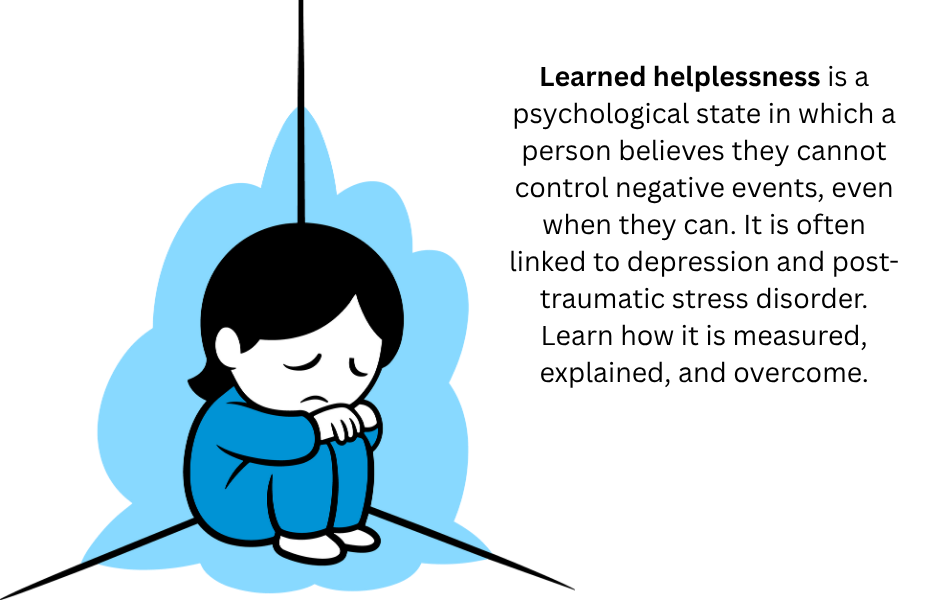Let's Talk About Learned Helplessness
Whether you believe you can or you can't, you're right.
Learned helplessness is a psychological state in which an individual believes they are powerless to change their situation after repeated exposure to uncontrollable negative events, even when opportunities for taking back control arise. This phenomenon was first identified in the 1960s by American psychologists Martin Seligman and Steven Maier during experiments with dogs. Seligman and Maier observed that dogs exposed to inescapable electric shocks later failed to escape or avoid shocks, even when escape was possible. This passivity suggested that the animals had essentially learned to be helpless, generalizing their lack of control from one situation to another.
A recent and widely discussed real-world example of learned helplessness in present-day America is the political disengagement and widespread sense of powerlessness among voters, particularly in the context of the 2024 presidential election and ongoing debates about Supreme Court reform.
In August 2024, political commentators and psychologists noted that many Americans had developed a “learned helplessness syndrome” in response to years of political polarization, perceived lack of agency, and the belief that their votes or actions would not change systemic issues. For instance, New York Times columnist Michelle Goldberg described how President Biden sought to “jolt the country out of its learned helplessness” in the face of ongoing political provocation and a sense that the system was unresponsive to input from citizens. Similarly, Slate’s Dahlia Lithwick argued that the public’s “generalized torpor and despair” reflected a deep-seated learned helplessness, especially regarding the Supreme Court, where many felt their voices were irrelevant to judicial outcomes.
In the Seligman and Maier experiments, dogs were divided into three groups. One group received escapable shocks, another inescapable shocks, and a third no shocks. Later, all dogs were placed in a situation where escape was possible. The dogs previously exposed to inescapable shocks made no attempt to escape, demonstrating the learned helplessness effect. This behavior was not due to physical incapacity but to a learned expectation that their actions were futile.
Subsequent research replicated these findings with humans, using loud noises instead of shocks. Participants who experienced uncontrollable noise later showed similar passivity and difficulty with problem solving, even when solutions were available. These results supported the idea that learned helplessness is not species-specific but a general psychological response to uncontrollable stress.
Learned helplessness is linked to the perception that outcomes are independent of one’s actions. Neuroscientific studies have shown that uncontrollable stress affects brain regions involved in motivation and decision-making, such as the prefrontal cortex and the dorsal raphe nucleus (sorry for going all science geek on you - MN). These changes can lead to symptoms resembling depression, including reduced motivation, impaired problem-solving, and emotional dysregulation.
In the late 1970s, Seligman and colleagues expanded the theory using attribution theory, proposing that individuals differ in how they explain negative events. Those with a pessimistic explanatory style—viewing negative events as permanent, personal, and pervasive—are more prone to learned helplessness and depression. This reformulation helped explain why some people are more vulnerable to helplessness than others.
Learned helplessness has been applied to understanding various human conditions, including clinical depression, aging, domestic violence, and academic underachievement. It is also observed in individuals who repeatedly fail to change negative personal circumstances (such as smokers who stop trying to quit after multiple failures) or people in abusive relationships who believe escape is impossible. These examples illustrate how a perceived lack of control can lead to passivity and disengagement, even when opportunities for change exist. Critics, however, caution against overgeneralizing the theory, as individual differences and context play significant roles.
Research suggests that learned helplessness can be mitigated by fostering a sense of control, encouraging problem-solving, and promoting optimistic explanatory styles. Therapeutic interventions, such as cognitive-behavioral therapy, aim to help individuals recognize and challenge helpless thoughts, thereby restoring motivation and agency.
Learned helplessness is a well-documented psychological phenomenon with broad implications for mental health and behavior. Its study has deepened our understanding of how perceived control, or a lack thereof, can easily shape human and animal responses to adversity.


